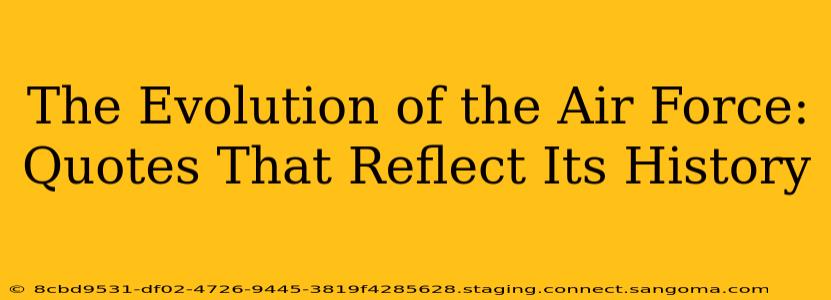The United States Air Force, a relatively young branch of the American military, boasts a rich and complex history. From its origins as a fledgling component of the Army Signal Corps to its current position as a globally dominant aerospace power, the Air Force's journey has been defined by technological innovation, strategic adaptation, and the unwavering dedication of its personnel. This evolution is best understood not just through dates and battles, but through the voices of those who shaped it. This article explores key moments in Air Force history through impactful quotes, examining the challenges overcome and the legacies forged.
From Balloons to Bombers: The Early Days
The Air Force didn't spring into existence fully formed. Its roots lie in the early days of aviation, a time of experimentation and daring. The Wright brothers' first flight in 1903 laid the groundwork for what would become a separate and powerful branch of the military. Early aviators faced immense risks, flying rudimentary machines in unpredictable conditions. This era of pioneering spirit is captured in the sentiment, though not a direct quote, that "the sky is not the limit when there are footprints on the moon." This reflects the audacious ambition that drove early aviation and continues to fuel Air Force innovation.
What were the major technological advancements in early Air Force history?
The early years of the Air Force saw breathtaking technological advancements. The transition from simple biplanes to more sophisticated aircraft capable of carrying heavier payloads and achieving greater altitudes was pivotal. The development of reliable engines, improved navigation systems, and the incorporation of radio communication transformed aerial warfare. These advancements, often developed in parallel with civilian aviation, steadily increased the Air Force's capabilities. The development of the first successful military aircraft, the Wright Model A, marked a significant turning point, demonstrating the potential for air power in military operations. This continued with the introduction of bombers capable of delivering significant destructive power, fundamentally changing the landscape of warfare.
World War II: The Rise of Air Power
World War II served as a crucible for the Air Force, proving its strategic importance on a global scale. The war saw the widespread adoption of air power, shifting the balance of conflict in unprecedented ways. General Henry H. Arnold's statement, "The future of warfare rests on air power," succinctly summarizes the profound impact of aerial combat during this era. The devastating bombing campaigns in Europe and the Pacific dramatically demonstrated the destructive capacity of air forces.
How did the role of the Air Force change during World War II?
World War II catapulted the Air Force into a position of central importance. Previously a relatively small component of the Army, it rapidly expanded, assuming a crucial role in strategic bombing, close air support, and reconnaissance. The war saw the development of new aircraft, technologies, and doctrines that reshaped military strategy. The scale of operations demanded an independent command structure, paving the way for the establishment of the United States Air Force as a separate branch of the military in 1947.
The Cold War: The Nuclear Age and Strategic Deterrence
The Cold War era presented the Air Force with a new set of challenges – the nuclear age. The threat of nuclear annihilation shaped strategic thinking, emphasizing the role of strategic deterrence. The development of intercontinental ballistic missiles (ICBMs) and advanced jet aircraft marked a new era of technological competition. While no single quote perfectly encapsulates this era's anxieties, the underlying theme was one of constant vigilance and technological superiority to maintain a precarious balance of power.
What was the Air Force's role in the Cold War?
During the Cold War, the Air Force played a critical role in maintaining strategic deterrence against the Soviet Union. This involved the development and deployment of nuclear weapons, the maintenance of a robust fleet of strategic bombers and ICBMs, and constant readiness for potential conflict. The Air Force's surveillance and reconnaissance capabilities were also vital in monitoring Soviet activities and maintaining global awareness.
The Post-Cold War Era: Adapting to New Challenges
The end of the Cold War ushered in a period of significant transformation for the Air Force. The focus shifted from large-scale conventional and nuclear warfare to smaller, more localized conflicts. The emergence of new technologies, such as stealth aircraft and precision-guided munitions, altered the tactics and strategies of modern warfare. A sentiment reflecting this adaptation is the understanding that "the Air Force must constantly evolve to meet the challenges of a changing world."
How has the Air Force adapted to post-Cold War conflicts?
The post-Cold War era required the Air Force to adapt to a new type of warfare. It moved from large-scale conflicts to smaller, more targeted operations involving precision strikes, close air support, and humanitarian missions. The increased emphasis on special operations and joint task forces underscored the need for greater interoperability with other branches of the military.
The Future of the Air Force: Space and Cyber Dominance
The Air Force continues to evolve, facing challenges in space, cyber warfare, and the development of hypersonic weapons. Maintaining technological superiority remains crucial. The constant drive for innovation is best reflected in the forward-looking perspective: "The future of air and space power is constantly being defined by our ability to adapt and innovate."
In conclusion, the history of the United States Air Force is a testament to human ingenuity, courage, and the constant pursuit of technological advancement. Through the words and actions of its members, it has shaped the course of global events. The quotes and discussions presented here provide only a glimpse into the multifaceted narrative of this vital branch of the US military. Its legacy continues to be written in the skies above and in the digital realms of the modern world.

